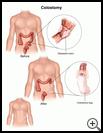
Colostomy and Ileostomy
________________________________________________________________________
KEY POINTS
- A colostomy and an ileostomy are surgical procedures to create a new opening in your belly, called a stoma. Your bowel movements will empty through the stoma and collect in a disposable bag outside the body.
- A colostomy or ileostomy may be needed for a short time or for a long time. The procedure may be done to give your intestine time to heal. If your large intestine and rectum are removed, you will have a colostomy for the rest of your life.
- After the procedure, you will be taught how to change, clean, and care for your stoma. Ask your provider about any changes you should make in your normal lifestyle.
________________________________________________________________________
What is a colostomy or ileostomy?
A colostomy and an ileostomy are surgical procedures. With either surgery, a part of your intestine is brought out of an opening in your belly, called a stoma. Your bowel movements will empty through the stoma and collect in a disposable bag outside the body.
An ileostomy brings the end of the small intestine through an opening in the wall of your belly to create a stoma.
A colostomy brings part of your large intestine, also called the colon, through an opening in the wall of your belly to create a stoma.
When are they used?
An ileostomy or colostomy may be used to treat:
- Inflammatory bowel disease, such as Crohn's disease or ulcerative colitis
- Tumors of the small intestine, large intestine (colon), or rectum
- Diverticulitis, which is swelling and irritation of pouches in the lining of your intestines that may get infected
- Damage to your intestines from a blockage, trauma, bleeding, or an infection
- An intestinal problem you have had since birth
A colostomy or ileostomy may be needed for a short time or for a long time. The procedure may be done to give your intestine time to heal. If your large intestine and rectum are removed, you will have a colostomy for the rest of your life.
How do I prepare for this procedure?
- Your healthcare provider will explain the surgery and how it will affect your bowel movements. Most hospitals have specially trained staff members to teach you what you need to know to take care of yourself. You may wear a bag on your belly for several days before surgery to find the best spot for the stoma. Understanding how to care for the stoma is the first step to help you deal with your concerns. You may want to have family members learn about your care so they can help you and give you support and encouragement.
- You may or may not need to take your regular medicines the day of the procedure. Tell your healthcare provider about all medicines and supplements that you take. Some products may increase your risk of side effects. Ask your healthcare provider if you need to avoid taking any medicine or supplements before the procedure.
- Tell your healthcare provider if you have any food, medicine, or other allergies such as latex.
- Follow your healthcare provider's instructions about not smoking before and after the procedure. Smokers may have more breathing problems during the procedure and heal more slowly. It is best to quit 6 to 8 weeks before surgery.
- Depending on why you need a colostomy or an ileostomy, you may be given instructions for clearing bowel movements from your intestines. Be sure to complete the bowel preparation as instructed, including what types of food and drink you can have in the days leading up to the procedure. The surgery may not be done if your intestine still has bowel movement in it.
- Your provider will tell you when to stop eating and drinking before the procedure. This helps to keep you from vomiting during the procedure.
- Follow any other instructions your healthcare provider gives you.
- Ask any questions you have before the procedure. You should understand what your healthcare provider is going to do. You have the right to make decisions about your healthcare and to give permission for tests or procedures.
What happens during this procedure?
You will be given a general anesthetic to relax your muscles and put you into a deep sleep. It will prevent you from feeling pain during the operation.
During the procedure, the surgeon will make a cut through your belly wall. If needed, the surgeon will take out the part of the intestine that is damaged or not healthy. The surgeon will bring the loose end of the intestine through a new opening in your belly wall (stoma) and attach the bowel end to the skin. A bag will be placed over the stoma to collect bowel movements.
What happens after this procedure?
After surgery, you will be given intravenous (IV) fluids. You will feel pain that can be helped with pain medicine and will go away in several days. You will be able to drink only small amounts of clear liquid right after the surgery. You will then slowly start eating regular food.
At first, your bag will be changed by nurses or a stoma therapist. You will be taught how to change, clean, and care for your stoma.
After an ileostomy, bowel movements are either liquid or pasty and drain constantly. After a colostomy, your bowel movements may be loose or firm, depending on which part of your intestine was removed or damaged.
Ask your healthcare provider:
- How and when you will get your test results, such as a tissue biopsy done during surgery to check for cancer or infection
- How long it will take to recover
- If there are activities you should avoid and when you can return to your normal activities
- How to take care of yourself at home
- What symptoms or problems you should watch for and what to do if you have them
Make sure you know when you should come back for a checkup. Keep all appointments for provider visits or tests.
Also, ask your provider about any changes you should make in your normal lifestyle including sexual activity. For example:
- Chewing foods well and drinking plenty of fluids. You may want to limit foods that can cause gas and odors, such as cabbage, onions, beans, and fizzy drinks.
- Avoiding heavy lifting and contact sports to prevent injury to the stoma.
- Preventing odor by cleaning the bag well and using a bag deodorant.
- Using a room deodorizer if necessary.
- Emptying the bag when it begins to fill to prevent leaking around the seal.
- Not wearing tight clothing over the stoma and bag.
What are the risks of this procedure?
Every procedure or treatment has risks. Some possible risks of this procedure include:
- You may have problems with anesthesia.
- You may have infection, bleeding, or blood clots.
- You may have blockage or narrowing of the stoma.
- Scar tissue may form and cause a blockage in your intestines.
Ask your healthcare provider how these risks apply to you. Be sure to discuss any other questions or concerns that you may have.
For more information, contact:
- The United Ostomy Associations of America
800-826-0826
http://www.uoaa.org. - American Cancer Society, Inc.
800-227-2345
http://www.cancer.org


